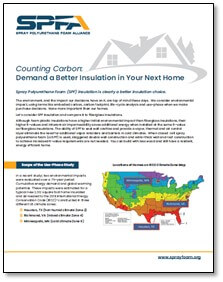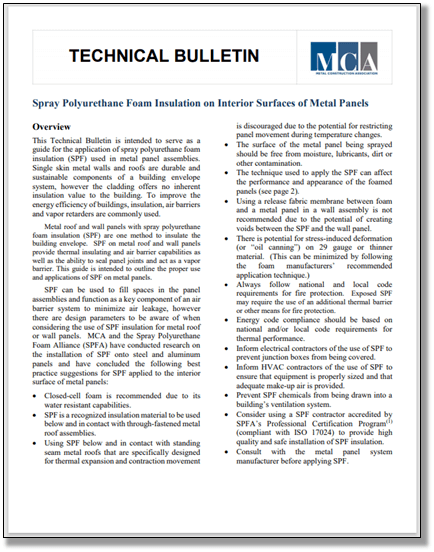Benefits of SPF
SPF is one of the most efficient insulation materials on the market today for roof and wall insulation, insulated windows and doors, and air barrier sealants.
- SPF provides an insulation and air-sealing product all-in-one
- Known for controlling noise transfer through and within the building, creating a quieter and more comfortable environment
- Helps control air and moisture movement in and out of buildings. In fact, closed-cell foams are the only insulations that are rated as FEMA flood-damage resistant materials that can withstand floodwaters up to 72 hours
According to a 2002 US Department of Energy report, heating and cooling costs amount to 50-70% of the energy used in the average American home. With the costs of heating and cooling going up, this is a concern of most home and building owners. Most of us know to turn off the lights to conserve energy but don't think to look to insulate and air seal our homes/buildings to more efficiently heat and cool them.
Consider the information from these sources and how they may apply to reduce the cost of your project:
- SPFA’s Resources page covering residential credits and commercial building tax deductions
- Database of State Incentives for Renewables & Efficiency (DSIRE)
- U.S. HUD Energy Efficient Mortgage Program
- American Council for an Energy Efficient Economy (ACEEE)
Additional Resources
SPFA has led the industry to accurately determine the environmental impacts of SPF insulation and roofing materials. In 2013, an industry-level, ISO-compliant life cycle assessment (LCA) was completed. This study led to the development of environmental product declarations (EPDs). Compliant with ISO requirements, this study was updated in 2018.

Counting Carbon: 2018 Residential Insulation Use Phase Report - An independent LCA practitioner, Sustainable Solutions, developed a report comparing the embodied energy and carbon impact of SPF and fiberglass insulation in typical single-family homes across three US climates, based on 2018 EPD reports. Both types of insulation were installed to the 2018 IECC prescriptive R-value. While SPF initially has slightly higher environmental impacts than fiberglass, its superior air sealing performance saves additional energy over time. This energy savings can offset the initial environmental impact difference within a few years, resulting in a significant net improvement over the home's lifetime. Full Report.

Counting Carbon: Low Global Warming Potential Blowing Agents for Closed-Cell Spray Foam summarizes the status of US regulations for SPF blowing agents as of March 2021 and provides links to the industry-wide EPDs for HFC and HFO based spray polyurethane foam insulation and roofing products.

2024 Life Cycle Assessment Study (Background Report) - This is the full industry-level ISO-compliant LCA for SPF. It available to energy, environmental and sustainability professionals looking to better understand the environmental impacts of SPF insulation and roofing materials. The LCA was conducted by independent, third-party, professional LCA practitioner Sphera (formerly PE International/thinkstep) following all relevant ISO standards 14040, 14044 and 14025.

2024 Environmental Product Declarations (EPDs) - Using the 2024 industry-level LCA report for SPF, Sphera created five ISO-compliant EPDs reviewed and published by ASTM, the EPD Program Operator. The alphabetical ASTM master list of EPDs can be found HERE. The individual spray foam EPD document links are provided below:
- EPD for Spray Polyurethane Foam Insulation Closed Cell Using Hydrofluorocarbons (CCSPF, HFC)
- EPD for Spray Polyurethane Foam Insulation Closed Cell Using Hydrofluoroolefins (CCSPF, HFO)
- EPD for Spray Polyurethane Foam Insulation Open Cell (OCSPF)
- EPD for Spray Polyurethane Foam Insulation Roofing Cell Using Hydrofluorocarbons (ROOFING SPF, HFC)
- EPD for Spray Polyurethane Foam Insulation Roofing Cell Using Hydrofluoroolefins (ROOFING SPF, HFO)
With ever-increasing concerns about durability and a building's ability to withstand severe weather events, the SPFA provides these documents.

Flood-Resistant Construction using Closed-Cell SPF (2016)
Closed-cell SPF insulation is the only cavity insulation recognized by FEMA as flood damage resistant and approved for reconstruction in flood-prone areas. SPFA has developed this guidance document to assist homeowners and contractors to rebuild using closed-cell SPF.
Structural Enhancement
Closed-cell SPF can also improve the structural performance wood and metal framed buildings. Several studies performed by the Canadian Council of Forest Industries (1991), the National Association of Home Builders (1992) and (1996) and SPFA (2007) show that closed-cell cavity insulation can dramatically improve the racking resistance of framed wall assemblies.
Research performed by SPFA member suppliers and the University of Florida show that closed-cell SPF applied beneath roof decks can significantly improve wind-uplift resistance and provide a secondary water barrier in the event that the primary roof covering is destroyed. This application of closed-cell SPF has been recognized as part of the Insurance Institute for Business and Home Safety (IBHS) Fortified Home program.
Roofing
Adverse Weather Performance
SPF roofing systems have exceptional sustainability characteristics. They save energy, are resistant to high winds, protect the substrate against damage from hail and wind driven debris, and are renewable (in many cases reusable rock aggregate, recycled roofing material injected into the coatings, and other renewable materials can be used to complement the SPF roof). SPF has proven durable during recent hurricanes, during hail storms, and other adverse weather conditions.
Independent post-hurricane surveys of roof systems by NIST1 and RICOWI2 found that SPF roofs perform extremely well. Researchers noted SPF’s high performance in moisture prevention, keeping the roofs intact and providing protection from hail and debris. SPF roofing systems tenaciously bond to a wide range of substrates, which greatly enhances its wind uplift resistance protecting buildings and contents during strong weather events. SPF roofing systems resist leaking from wind driven debris and hail due to its closed cell properties and any damaged areas can be quickly repaired.
RICOWI (Roofing Industry's Committee on Weather Issues) is a non-profit organization that works to identify and address important technical issues related to the cause of wind and hail damage. SPFA is a founding member of this organization and has done work in the past to help coordinate and execute research after major weather-related incidents. RICOWI's research and investigation after these events has shed quantifiable light on the durability of spray foam roofing. For more information on their findings, please contact RICOWI.
1. “Performance of Physical Structures in Hurricane Katrina and Hurricane Rita: A Reconnaissance Report”, National Institute of Standards and Technology NIST Technical Note 1476. June 2006 (Section 3.2)
https://ws680.nist.gov/publication/get_pdf.cfm?pub_id=908281
2 Various reports (2006-2017) on hurricane and hail damage to roofing systems by Roofing Industry Committee on Weather Issues, Inc. (RICOWI) and Oak Ridge National Laboratories (ORNL) https://www.ricowi.com/reports
In response to concerns with compatibility of SPF with other building materials and systems, the SPFA has partnered with different organizations to research these concerns. Below are a sample of scientific reports generated by this research.
SPF Roofing & Solar Panels: An Ideal Match
SPF roofing and solar panels are, more than ever, combined on the roof as an optimized energy solution. In high performance structures, energy is both saved and generated. SPF roofing provides a protective cover and enhances energy savings, while solar panels generate renewable clean energy. Together, the two systems dramatically reduce the building’s dependence on non-renewable energy sources. More information on SPF and photovoltaic systems can be found in SPFA-150 Photo-Voltaic Systems and SPF Roof Systems. Guidance for all SPF applications can be downloaded from the SPFA TechDoc library.
Zero Net Energy Buildings
Zero Net Energy (ZNE) buildings are in demand. Because of their unparalleled ability to seal and insulate the building envelope, SPF roofing and insulation are common materials utilized to achieve zero net energy. SPF roofing and solar are an integral design element of any ZNE building.

SPF and cPVC Pipes and Fittings (2009)
This report highlights the results of an independently administered research project that debunks the allegations of SPF incompatibility with cPVC piping. This report is for SPF professionals, building code officials, customers or anyone responsible for a building that contains both SPF and cPVC piping. A letter from an independent consultant validating these results can be found here as well as a 2014 statement from the California State Fire Marshal here.

SPF and Termites
This document addresses questions about inspection and treatment of potential termite infestations in buildings using SPF Insulation. It provides basic information about termite identification, inspection and treatments methods as well as discusses the importance of air-sealing and insulation of critical areas using SPF. It also presents code-compliant solutions to address these concerns.
SPFA and the Spray Foam Coalition have developed this termite video on application of SPF in basements and crawlspaces with a high probability of termite infestation. State residential building codes have special requirements including inspection gaps at the top and bottom of the foundation walls.

SPF and Metal Buildings (2015)
This document, published by the Metal Building Manufacturer’s Association, represents the collaborative research between SPFA, MBMA and the Metal Construction Industry to address concerns with using SPF in metal buildings.

SPF and Recessed Lighting (2016)
This National Electrical Manufacturers Association (NEMA) document was developed from the findings of a research project conducted by SPFA and NEMA examining the interaction between SPF directly applied in contact with “can-lights” or recessed light fixtures.
Spray Foam And Indoor Air Quality (IAQ)
Indoor Air Quality (IAQ) has become a very important topic in recent years, particularly as buildings have become tighter as a result of air-sealing and energy efficiency measures employed by the construction, building science, architectural, efficiency, code and sustainability communities. One of the reasons SPF has become such a popular solution is because of the high-performing combined features of high R-Value and air-sealing. Both of these features are in high demand by customers and driven by building and energy codes. Interestingly these features apply to both roofing (the forgotten fifth wall) and insulation.
Benefits of SPF:
- Provides high-performing insulation and air-sealing.
- Applied to both roofing and insulation.
- Enhances indoor comfort and consistent environment.
- Reduces outdoor pollutants and allergens, improving conditions for allergy sufferers.
- Improves efficiency of heating and cooling systems.
Things to consider:
- Mechanical Ventilation:
- Essential due to reduced air leakage.
- Prevents trapping of odors and pollutants inside the building.
- Ensures good, consistent air-flow within conditioned spaces.
- Combustible Gas Appliances:
- Must be properly vented to avoid Carbon Monoxide (CO) buildup.
- Important for occupant safety, especially in highly insulated and air-sealed buildings.
- Use of plug-in CO detectors recommended.
- Professional Installation and Consultation:
- Use professional, experienced SPF contractors.
- Consider consulting with energy and environmental professionals like BPI Analysts or RESNET HERS Raters for substantial building changes.












